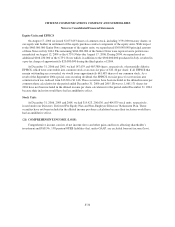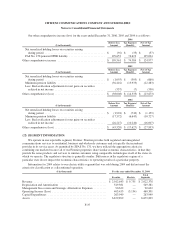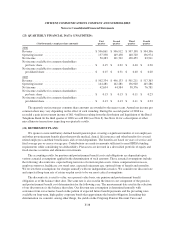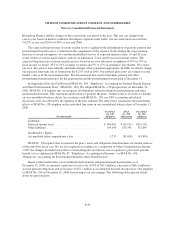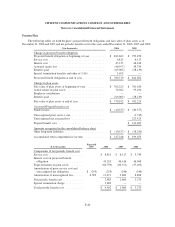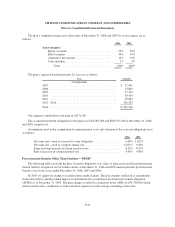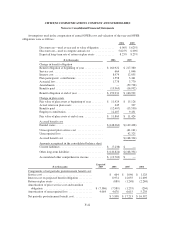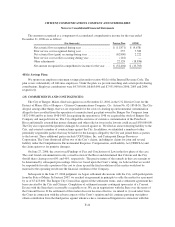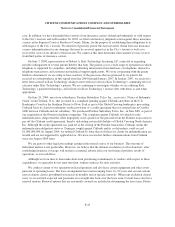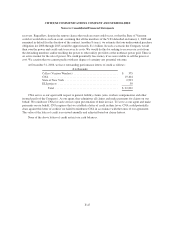Frontier Communications 2006 Annual Report Download - page 94
Download and view the complete annual report
Please find page 94 of the 2006 Frontier Communications annual report below. You can navigate through the pages in the report by either clicking on the pages listed below, or by using the keyword search tool below to find specific information within the annual report.
CITIZENS COMMUNICATIONS COMPANY AND SUBSIDIARIES
Notes to Consolidated Financial Statements
minimum rental commitments for all long-term noncancelable operating leases and future minimum capital lease
payments for continuing operations as of December 31, 2006 are as follows:
($ in thousands)
Operating
Leases
Year ending December 31:
2007 ............................................ $ 15,794
2008 ............................................ 9,817
2009 ............................................ 9,693
2010 ............................................ 8,593
2011 ............................................ 7,311
Thereafter ........................................ 18,185
Total minimum lease payments ....................... $ 69,393
Total rental expense included in our results of operations for the years ended December 31, 2006, 2005 and
2004 was $16,281,000, $16,859,000 and $17,410,000, respectively.
We are a party to contracts with several unrelated long distance carriers. The contracts provide fees based on
traffic they carry for us subject to minimum monthly fees.
At December 31, 2006, the estimated future payments for obligations under our noncancelable long distance
contracts and service agreements are as follows:
Year
($ in thousands)
2007 ................................................ $ 26,449
2008 ................................................ 18,899
2009 ................................................ 16,610
2010 ................................................ 7,382
2011 ................................................ 165
Thereafter ............................................ 660
Total ................................................ $ 70,165
We sold all of our utility businesses as of April 1, 2004. However, we have retained a potential payment
obligation associated with our previous electric utility activities in the state of Vermont. The Vermont Joint
Owners (VJO), a consortium of 14 Vermont utilities, including us, entered into a purchase power agreement with
Hydro-Quebec in 1987. The agreement contains “step-up” provisions that state that if any VJO member defaults
on its purchase obligation under the contract to purchase power from Hydro-Quebec the other VJO participants
will assume responsibility for the defaulting party’s share on a pro-rata basis. Our pro-rata share of the purchase
power obligation is 10%. If any member of the VJO defaults on its obligations under the Hydro-Quebec
agreement, then the remaining members of the VJO, including us, may be required to pay for a substantially
larger share of the VJO’s total power purchase obligation for the remainder of the agreement (which runs through
2015). Paragraph 13 of FIN No. 45 requires that we disclose “the maximum potential amount of future payments
(undiscounted) the guarantor could be required to make under the guarantee.” Paragraph 13 also states that we
must make such disclosure “… even if the likelihood of the guarantor’s having to make any payments under the
guarantee is remote…” As noted above, our obligation only arises as a result of default by another VJO member,
such as upon bankruptcy. Therefore, to satisfy the “maximum potential amount” disclosure requirement we must
assume that all members of the VJO simultaneously default, a highly unlikely scenario given that the two
members of the VJO that have the largest potential payment obligations are publicly traded with credit ratings
equal to or superior to ours, and that all VJO members are regulated utility providers with regulated cost
F-46


